Rennie Scaysbrook | October 20, 2022
Two bikes with old hearts—which one is best for some modern retro riding?
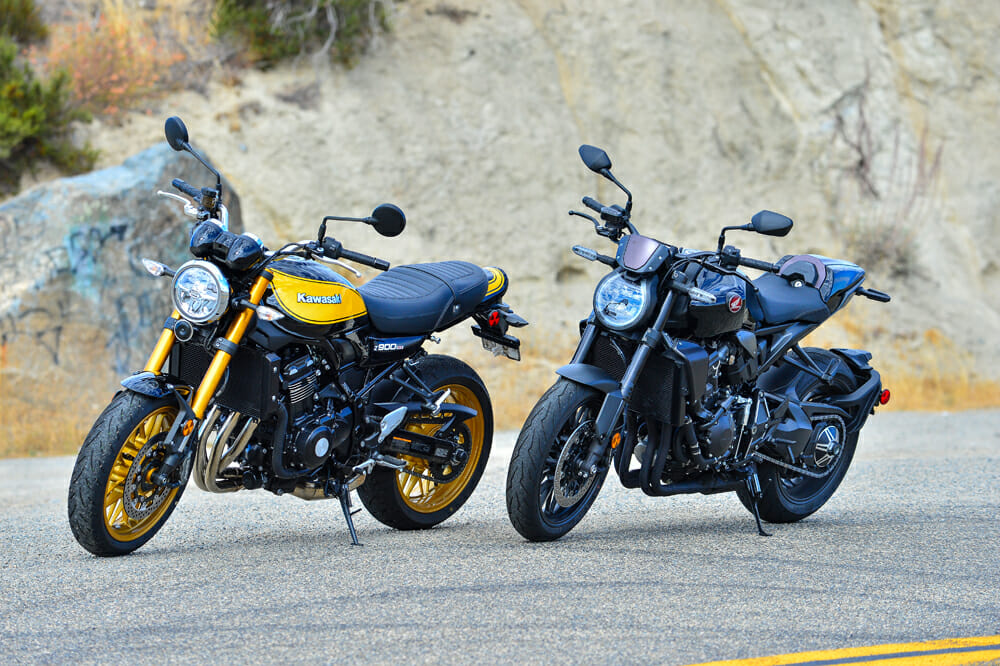 If you had to pick just one based off looks, which one are you going for?
If you had to pick just one based off looks, which one are you going for?
Photography by Kit Palmer
You could argue both of these bikes are not retro at all. The Kawasaki Z900RS SE might look like it comes from 50 years ago, but it’s effectively a Z900 SE under the bonnet, all dressed up in clothing its dad wore in the early ’70s.
On the flip side, Honda’s CB1000R Black Edition channels more modern aesthetics, but if you squint you can still see the silhouette of the 1969 Honda CB750, the bike that made Honda the powerhouse it is today.
Both bikes run four-cylinder engines, the Honda eking out a 55cc advantage at 998cc to the Kawasaki’s 943cc. This capacity increase gives the Honda a 32-horsepower gain over the Kawasaki—143 horsepower to the Kawasaki’s 111 horsepower (claimed, of course)—but this test is more a tale of the ride comfort than any performance numbers.
The Kawasaki and Honda are going after pretty much the same customer. Neither is concerned with the current hyper-naked bike scene that’s basically superbikes without the fairings, both more interested in the kind of laidback riding that made a generation fall in love with motorcycles in the first place.
We spent a week with both the Honda and Kawasaki and our findings were surprising, least of all because each bike shined in areas we didn’t expect.
Kawasaki Z900RS SE
We’ve been big fans of the Kawasaki Z900RS since it came out in 2018. We spent the best part of a year with the original, tinkering and playing and fitting a few choice mods like Dymag wheels, a Yoshimura muffler and a few cosmetic bits like a fender eliminator and tank guards.
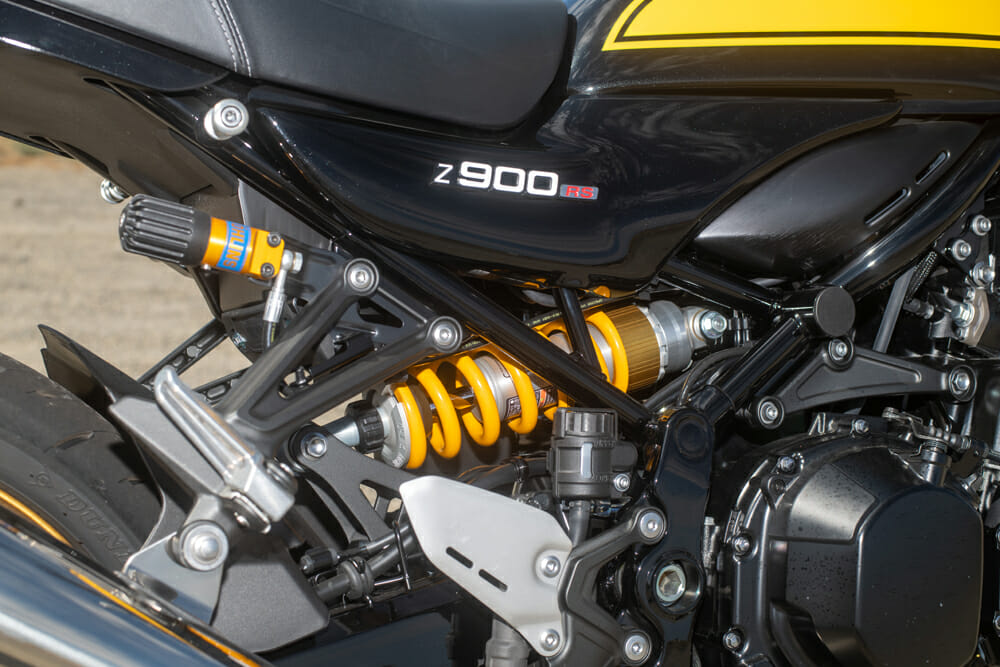 The Kawasaki’s Ӧhlins S46 shock is a superior unit to the Honda’s Showa shock.
The Kawasaki’s Ӧhlins S46 shock is a superior unit to the Honda’s Showa shock.
Fast forward four years and the SE is now king dong in Kawasaki’s retro lineup, and it’s got a price point to suit. At $13,499, and that’s before you go thinking about taxes and dealer charges, etc., the SE represents the top echelon of modern retro motorcycles in terms of price—but not entirely by spec.
Kawasaki has taken their Z900 SE and dressed it up all fancy to create the Z900RS SE. It’s got the same 948cc four-cylinder motor, the same tubular trellis steel chassis, same fully adjustable front suspension and Ӧhlins S46 shock, and the same radially mounted Brembo monobloc brakes mated to a conventional ABS system.
Being a retro ride, Kawasaki hasn’t graced the Z900RS SE with the kind of electronics one would expect for a bike costing this much. There’s no quickshifter, no cruise control, no heated grips or Inertial Measurement Unit, which then dictates a lack of Cornering ABS, lean-angle-sensitive traction control, etc.
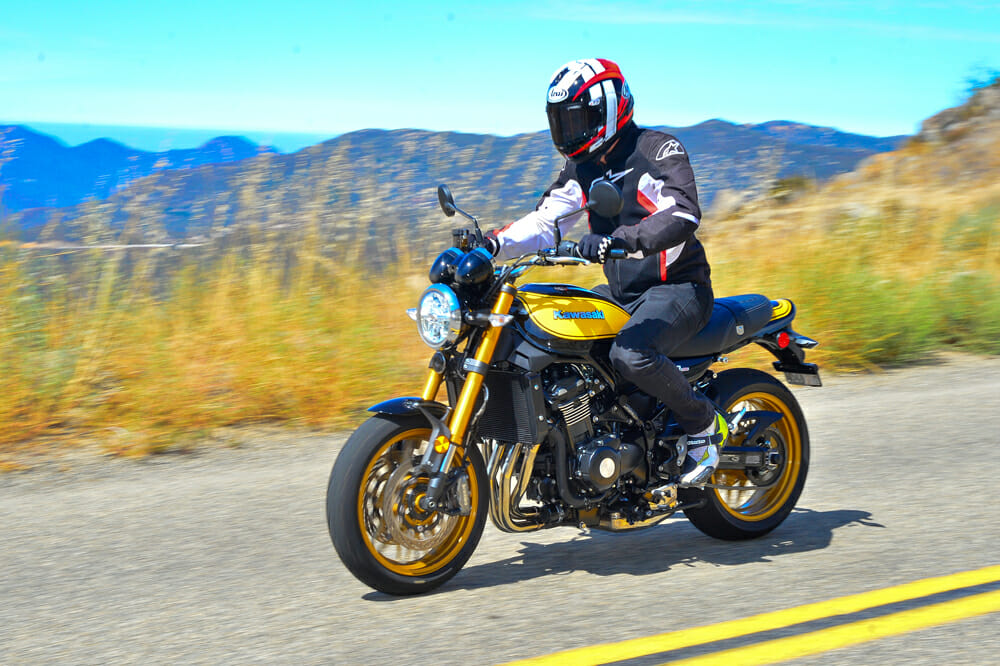 Sometimes a roomy, old-school riding position is best.
Sometimes a roomy, old-school riding position is best.
The good thing is, you barely think about any of this while riding. Except for the absence of a quickshifter, the Kawasaki’s ride is delightful. The wretched throttle response we experienced on our 2018 test bike has been largely eradicated and the suspension action, especially the rear shock, is smooth and compliant without being overly stiff.
And then you get into that motor. We absolutely love that 948cc lump. It’s got this beautifully gruff intake noise matched to plenty of lowdown torque, although it does run out a little faster up top than I would have liked.
The Kawasaki’s chassis balance leans slightly towards the back of the bike, so the initial steering can be a bit lazy. You have to weight the front a bit more than you’d expect to make for fast initial steering, especially at high speed, and is a trait we also found evident when testing the Honda back-to-back.
There’s absolutely no denying the Kawasaki is the winner in the looks department. A retro suit, when worn correctly, almost always outclasses modern attire and Kawasaki has done well to stay true to the ethos of the original Z1 900 from the early 1970s without losing touch with modern reality. Ironically, part of what makes it look so good is one of its best riding features, and that’s the long plank seat. It’s one of the most comfortable of any 1000cc naked bikes on the market today, making long rides nowhere near as painful as one might expect.
Honda CB1000R Black Edition
“Give yourself to the Dark Side…” Darth Vader’s famous line to Luke Skywalker might be more adept for the CB1000R Black Edition rider, as its sheer lack of anything resembling color other than black would make the Dark Lord himself proud.
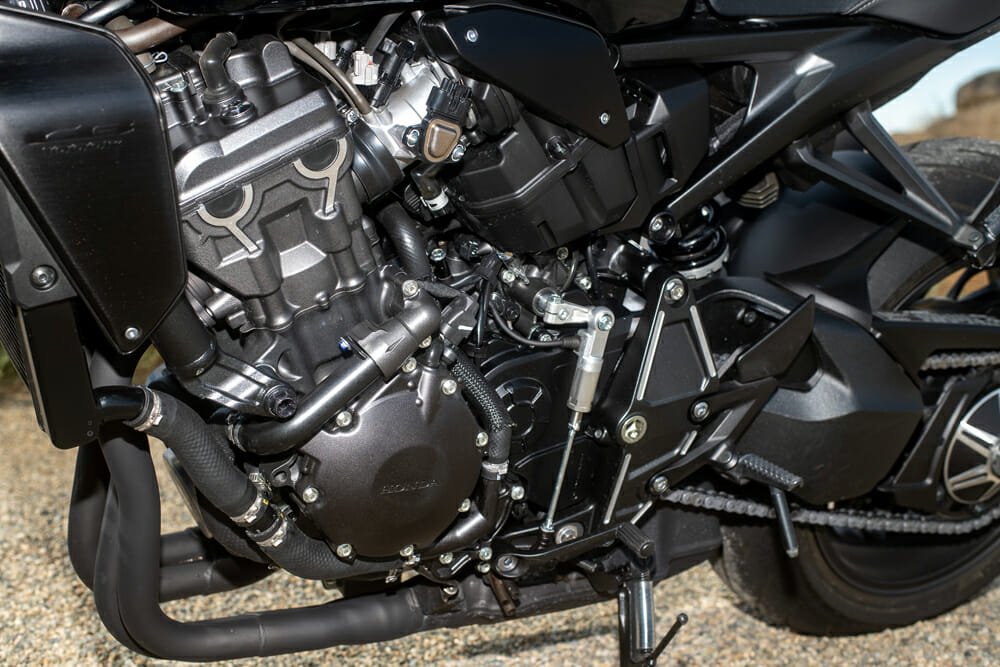 Honda’s 998cc motor is a great little thing with lots of lowdown torque mated to a wheelie-pulling top-end.
Honda’s 998cc motor is a great little thing with lots of lowdown torque mated to a wheelie-pulling top-end.
The CB1000R is the same as the Black Edition; it’s the only one you can buy in North America, with American Honda doing away with the red color scheme they must have thought wasn’t black enough.
At $12,999, the Honda undercuts the Kawasaki by $500 and for that you get more power, a near perfectly mapped quickshifter, three power modes and adjustable traction and engine brake control in the electronics (although no IMU/Cornering ABS/cruise control or heated grips), so in reality, the spec is pretty close to what you’re getting with the Kawasaki.
Perhaps the Honda is aimed at a slightly more modern rider than the Z900RS SE is, but not by much. There’s still traces of the OG 1969 Honda CB750 in there, especially in the tank design, which can be an issue for a rider with long legs.
The indents are very pronounced, and I struggled to find a comfortable stance at times on the CB. It’s an agile and nimble motorcycle, certainly faster steering than the Kawasaki but with a rear shock that is not up to the quality of the Kawasaki’s Ӧhlins unit.
This gives the Honda a three-fold problem in that it sinks too fast under acceleration, transmits too much shock to the rider over sharp bumps and doesn’t allow the chassis to hold its line as well while you’re slowly dialing in the power when riding quickly.
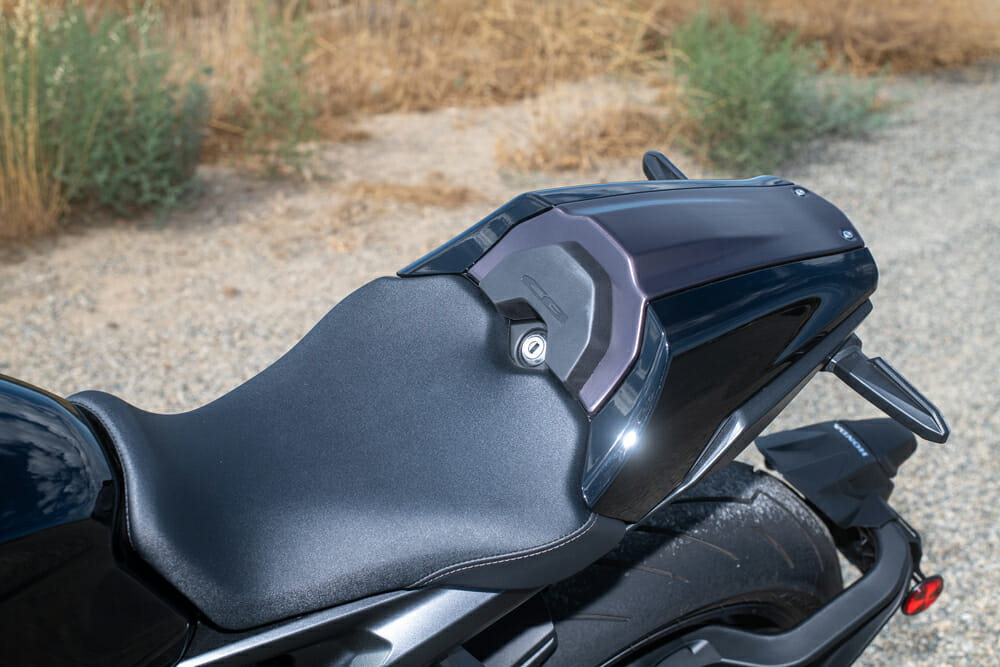 The stubby seat on the CB doesn’t leave much room to move around (at least not with the passenger seat cover fitted).
The stubby seat on the CB doesn’t leave much room to move around (at least not with the passenger seat cover fitted).
On the plus side, the front suspension offers a compliant ride and soaks up many of the corrugations you’ll hit. Under brakes and through long bends, the front tracks well but gets let down by the shock when you get back on the gas.
Honda has certainly got the Kawasaki licked when it comes to the electronics. Four modes (Sport, Road and Rain, plus a customizable User mode) gives plenty of options to tailor the ride how you want and given the fact you’ve got a fair bit more power on tap than the Kawasaki, the specs and performance on offer back each other up.
The Honda’s is a slightly cramped ride position in that the narrow handlebars sit at a slightly strange angle and the seat isn’t the most comfortable for a long day’s ride. The Honda is more adept at short, zippy rides through the canyons for lunch, rather than an epic full day, something you can do on the Kawasaki despite its near total lack of electronics (one would love cruise control here).
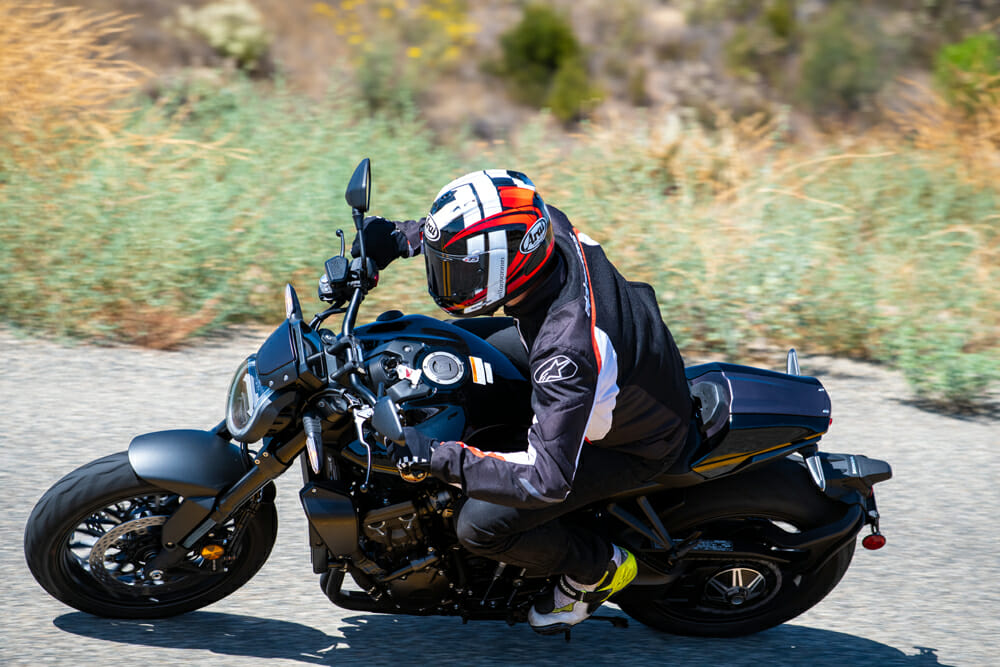 Riders a little shorter than Rennie’s 6’1” frame might find the CB1000R’s riding position a bit more comfortable than he did.
Riders a little shorter than Rennie’s 6’1” frame might find the CB1000R’s riding position a bit more comfortable than he did.
One of the Honda’s trump cards must be the engine and the fact the gearing is shorter than I would have expected. This allows the Honda rider to access some ripping acceleration easily, with the extra benefit of being in the meat of the torque curve for much of the time when in city/slow-speed riding.
So, which one do you take?
For two bikes that look pretty different, they ride remarkably similar. If the Honda had a better rear shock, I’d certainly give that portion of the test to the Big H. The Kawasaki performs much better than I remember my 2018 test bike did thanks to the introduction of the Ӧhlins shock, but it’s let down by a higher price tag than I feel is warranted for a bike that doesn’t come with at least a quickshifter, let alone cruise control or heated grips.
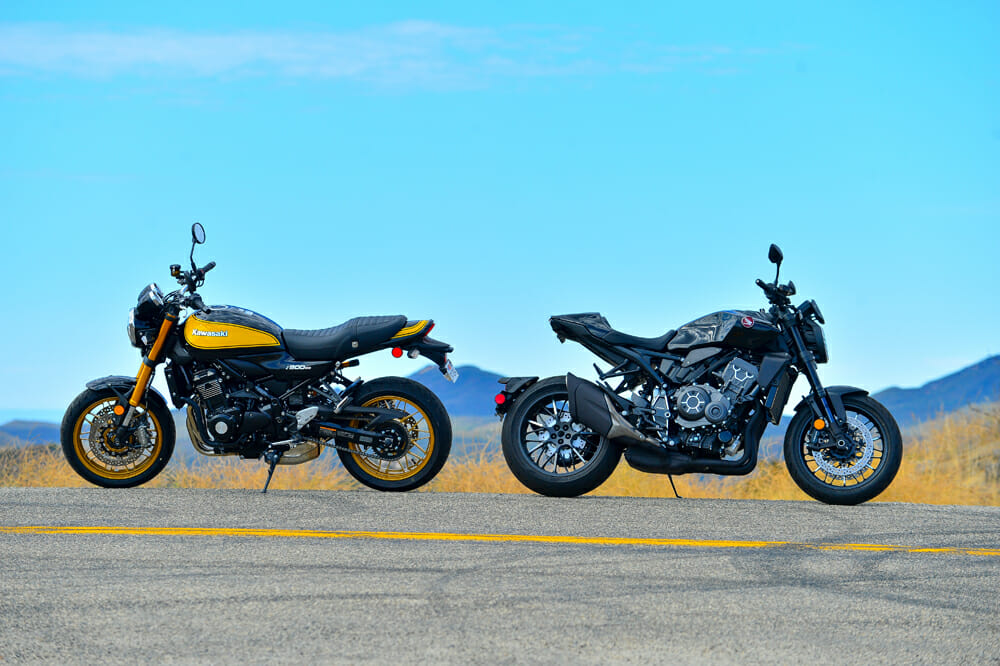 The one on the left is a modern interpretation of a classic, the one on the right is more a doff of the cap to Hondas of the past. We’re leaning towards the Z900RS SE’s aesthetic.
The one on the left is a modern interpretation of a classic, the one on the right is more a doff of the cap to Hondas of the past. We’re leaning towards the Z900RS SE’s aesthetic.
At the end of the day, neither bike is going to win any performance naked-bike shootout. So, that means, at least for me, it’s all about which bike I will happily crack a beer and look at in my garage for longer than I should, so long as there’s decent performance to back up the looks.
And despite not having the bits I feel it should have, I still must give the win to the Kawasaki Z900RS SE.
For my money, it’s one of the prettiest bikes on the market today. It’s a comfortable all-around ride, capable of long distances as much as it is riding to the beach or scratching with a few friends in the canyons.
The Honda’s ride position was a bit of a let-down in that I found it didn’t offer the right position for someone of my height (6’1”). The CB’s motor was indeed more exhilarating than the Z900RS SE’s, but as I said at the beginning of this test, outright performance isn’t everything here.
The Kawasaki ticks almost all the boxes for me, so for that, it takes the W. CN
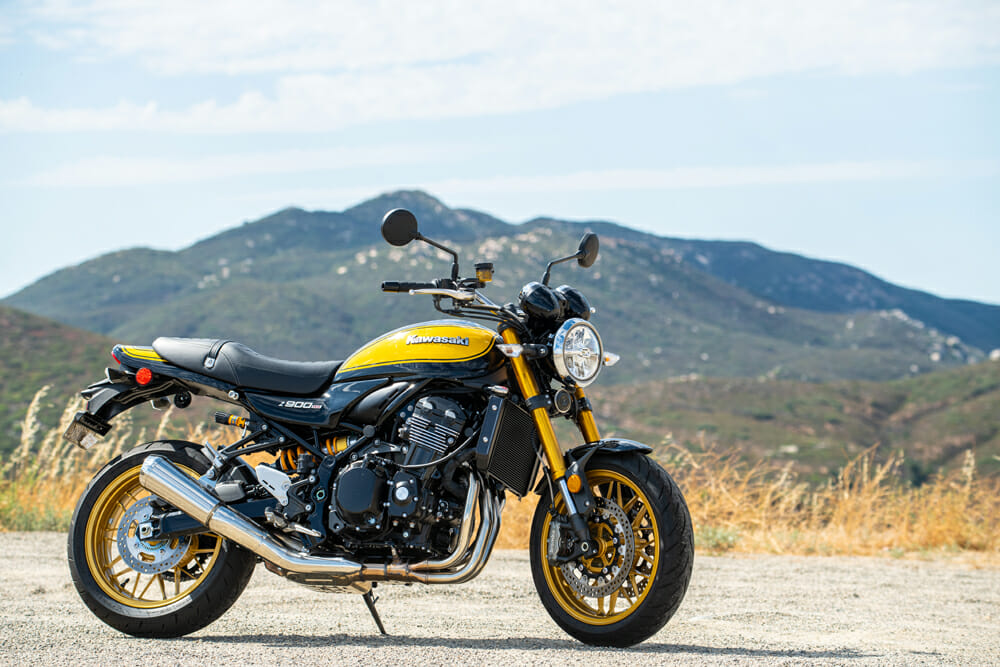
2022 Kawasaki Z900RS SE Specifications
| MSRP: |
$13,449 |
| Engine: |
Inline 4-cylinder 4-stroke |
| Valvetrain: |
DOHC, 16-valve |
| Cooling system: |
Liquid |
| Displacement: |
948cc |
| Bore x stroke: |
73.4 x 56mm |
| Compression ratio: |
10.8:1 |
| Clutch: |
Wet multi-plate |
| Transmission: |
Six-speed |
| Chassis: |
Tubular steel trellis frame |
| Front suspension: |
41mm inverted USD fork fully adjustable |
| Rear suspension: |
Horizontal back-link Ӧhlins S46 single shock, fully adjustable |
| Front brake: |
Dual 300mm dual semi-floating discs, radial-mounted 4-piston Brembo calipers; ABS |
| Rear brake: |
250mm disc, 1-piston caliper; ABS |
| Front tire |
120/70 ZR17 |
| Rear tire: |
180/55 ZR17 |
| Wheelbase: |
58.1 in. |
| Seat height: |
31.5 in. |
| Fuel capacity: |
4.5 gal. |
| Weight (curb, claimed): |
471.9 lbs. |
| Color: |
Yellow Ball |
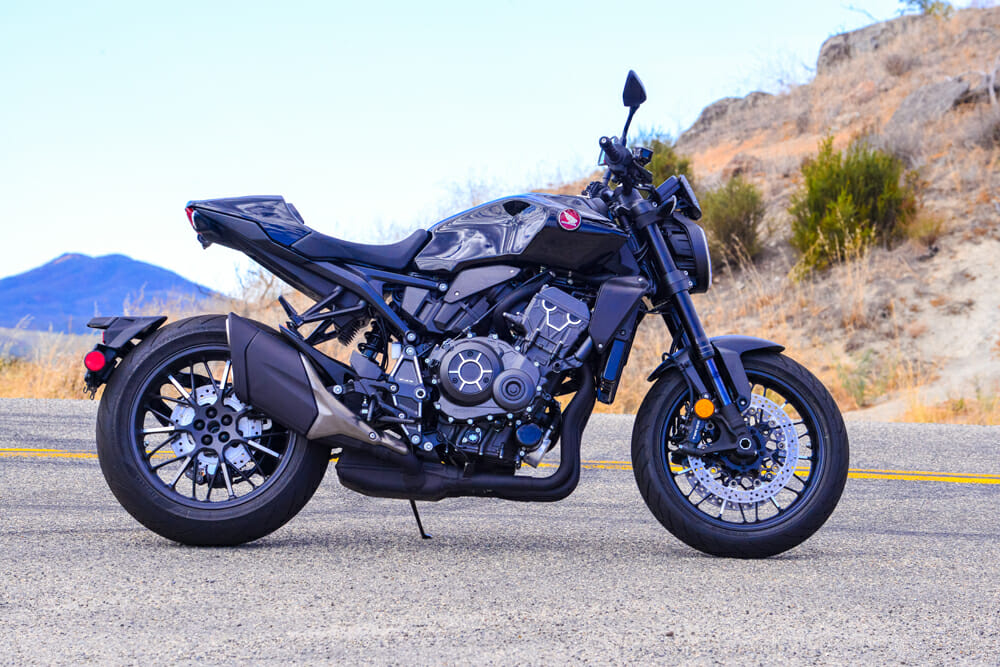
2023 Honda CB1000R Black Edition Specifications
| MSRP: |
$12,999 |
| Engine: |
Inline 4-cylinder 4-stroke |
| Valvetrain: |
DOHC 16-valve |
| Cooling System: |
Liquid |
| Displacement: |
998cc |
| Bore x stroke: |
75 x 56.5mm |
| Compression ratio: |
11.6:1 |
| Clutch: |
Wet multi-plate |
| Transmission: |
6-speed |
| Chassis: |
Steel backbone |
| Front suspension: |
43mm Showa SFF-BP, fully adjustable |
| Rear suspension: |
Showa single shock, fully adjustable |
| Front brake: |
Dual radial-mounted four-piston calipers with full-floating 310mm discs; ABS |
| Rear brake: |
Single caliper 256mm disc; ABS |
| Front tire: |
120/70 ZR17 in. |
| Rear tire: |
190/55 ZR17 in. |
| Wheelbase: |
57.3 in. |
| Seat height: |
32.7 in. |
| Fuel capacity: |
4.3 gal. |
| Weight (curb, claimed): |
467 lbs |
| Color: |
Graphite Black |